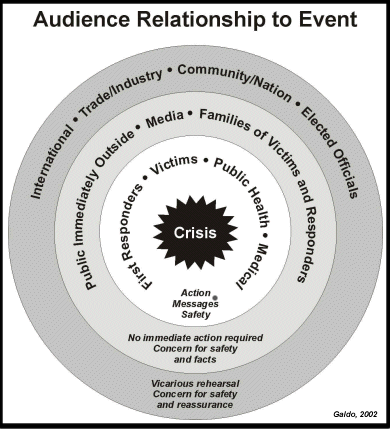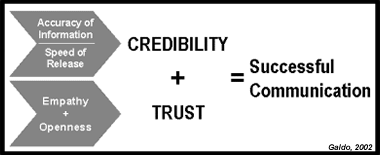The receiver of your communication will be judging the content of the message, the messenger, and the method of delivery. Each of these aspects must be considered in the planning for crisis and emergency risk communication. The public's awareness of the government is heightened during a crisis. A lack of continuity, control, adequate resources, or full knowledge of the event can invoke fear and threaten social unity.
Public health communicators must understand their audiences' point of view and that different audiences have different concerns. As you develop messages, you will want to understand how audiences judge messages. Also, you will want to know how to make your messages effective.
8
Different audiences should be considered when communicating in a crisis, based on their relationship to the incident and/or on demographics. Each of these audiences will be looking for a specific message.
2 Prioritize the development of messages for each audience based on the level of the audience's involvement. Audience segmentation and demographics are still relevant during a crisis.
Remember the basics when creating your messages:
- Education
- Current subject knowledge and experience
- Age
- Language spoken/read
- Cultural norms
- Geographic location.
The following table lists possible audiences and their likely concerns that you should consider when developing your crisis and emergency risk communication.
3
Possible Audiences Concerns Public within the circle of disaster or emergency, for whom action messages are intended personal safety, family safety, pet safety, stigmatization (the fear and isolation of a group perceived to be contaminated or risky to be associated with), property protection Public immediately outside the circle of disaster or emergency, for whom action messages are not intended personal safety, family safety, pet safety, interruption of normal life activities Emergency response and recovery workers, law enforcement resources to accomplish response and recovery, personal safety, family safety, pet safety Public health and medical professionals involved in the disaster response personal safety, resources adequate to respond Family members of victims and response workers personal safety, safety of victims and response workers Health care professionals outside the response effort vicarious rehearsal of treatment recommendations, ability to respond to patients with appropriate information, access to treatment supplies if needed/wanted Civic leaders: local, State, and national response and recovery resources, liability, leadership, and quality of response and recovery planning and implementation; opportunities for expressions of concern; trade and international diplomatic relations Congress informing constituents, review of statutes and laws for adequacy and adjustment needs, opportunities for expressions of concern Trade and industry business issues (loss of revenue, liability, business interruption, and protection of employees) National community vicarious rehearsal, readiness efforts started International neighbors vicarious rehearsal, readiness efforts started International community vicarious rehearsal, exploration of readiness Stakeholders and partners specific to the emergency included in decision making and access to information Media personal safety, access to information and spokespersons, deadlines Audiences judge the effectiveness of messages on several levels:
- Speed of communication
- Content
- Trust and credibility.
Was the message timely? Research indicates that the first message received on a subject sets the stage for comparison of all future related messages. Also, the speed with which you respond to the public can be an indicator of how prepared you are to respond to the emergency, that there is a system in place, and that needed action is being taken. The importance of timely communication can be seen in the example of the Denver laboratories anthrax response.
First impressions are lasting impressions. Succeeding does not mean having all the answers; it means having an early presence so the public knows you are aware of the emergency and that there is a system in place to respond. A great message delivered after the audience has moved on to other issues is a message not delivered at all.
The public will be listening for factual information and some will be expecting to hear a recommendation for action.
10 Get the facts right, repeat them consistently, avoid sketchy details early on, and ensure that all credible sources share the same facts. Speak with one voice. Consistent messages are vital. Inconsistent messages will increase anxiety and quickly diminish experts' credibility.
Research by Dr. Vincent T. Covello shows that there are basic elements to establishing trust and credibility through communication:
9
- Empathy and caring
- Competence and expertise
- Honesty and openness
- Commitment and dedication.
Dr. Peter Sandman suggests that a fifth factor, accountability, can also be an element for establishing trust and credibility.
Empathy and caring should be expressed within the first 30 seconds. According to research, being perceived as empathetic and caring provides greater opportunity for your message to be received and acted upon.
Previous experience and demonstrated abilities in the current situation feed the perception of competence. Another useful way to build the perception of competence and expertise among your audiences is to have established a relationship with them in advance of the emergency. If that is not possible, ask a third party who already has the audience's confidence to express confidence in you or your organization.
Being honest and open does not mean being paternalistic in your communication, but instead being participatory: give people choices and enough information to make appropriate decisions. Do not pretend you do not have the information. Tell the public why the information is not available for release at the time (e.g., verifying information, notifying organization, not your information to release). Being open and honest means allowing the public to watch the grit of the process while reminding them that this process is what drives the quality of the emergency response. Cut the professional jargon and euphemisms; they imply insecurity and lack of honesty.
State up front your organization's objective in this emergency response and commit to reaching that objective. Show dedication by sharing in the sacrifices and discomforts of the emergency response. Dedication means not leaving the emergency until the community has recovered. This often means staying in touch with the community long after the media loses interest in the story.
Dr. Sandman says, the great paradox of trust is the more you ask for it, the less you get it. So find ways to be accountable, to be able to prove what you say. Have neutral observers (or better yet, opponents) certify your integrity. This reduces the need for trust, while paradoxically increasing trust.
Developing Effective Messages
4
Effective message development begins by establishing objectives for your emergency risk communication. Use the Emergency Risk Communication Objectives Development Worksheet to define your communication objectives.
Effective messages all have the following characteristics:
11
- Clarity
- Consistency
- Appropriate tone and appeal
- Responsiveness.
When developing an effective message, remember the following tips developed by Dr. Vincent T. Covello and others.
- Make the message short, concise, and focused (6th-grade level) for the general public. (Note: Many word processing packages (including Word and WordPerfect) have a reading level feature. You can also use the SMOG Readability Index to determine the reading level of your message.
- Cut to the chase; give relevant information only.
- Give action steps in positives, rather than negatives .
- Repeat the message.
- Frame actions in three's, use rhyme, or create an acronym .
- Use personal pronouns for the organization. (e.g., "We are committed to . . .")
When developing a message, you should avoid the following elements:
- Technical jargon/unnecessary filler
- Condescending or judgmental phrases
- Attacks
- Promises/guarantees
- Speculation that could be mistaken for fact
12,
13
- Discussion of money
- Humor.
Remember that your message must:
- Be short
- Be relevant
- Give positive action steps
- Be repeated.
For more information on effective message development, see Dr. Vincent T. Covello's article, Message Mapping.
6
Effective Message Checklist
You can use the chart below to rate the effectiveness of your message.
Messages can be incorporated into draft materials for testing. Potential materials include brochures, kits for health care providers and media, and fact sheets.
Once message concepts and draft materials are developed, they will be tested with target audiences, the most important people of all. Communication product pre-testing with audience members will ask questions like the following.
- Which of these messages gives you the most important new information? (to explore how attention-getting and how helpful the message is)
- What is this message trying to say? (to explore whether the message is understandable)
- Do you feel as if these messages are meant for you or for someone else? What about them makes them relevant/not relevant to you?
- Will this message motivate you to take action? (e.g., find out about your exposure status)
(See "Message Development and Pretesting," an excerpt from CDCynergy, 2001)

